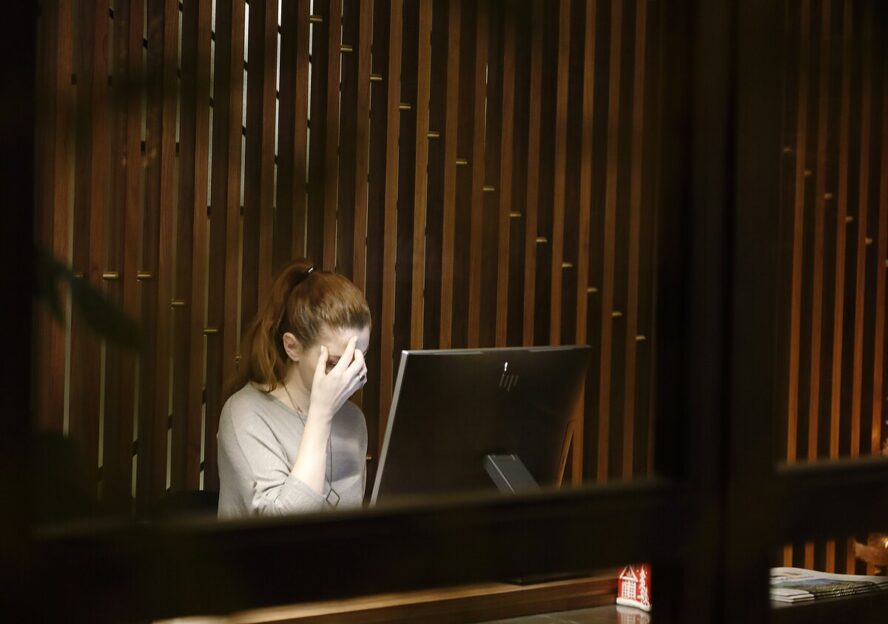
You’d think we’d have learned our lesson after Covid confinement, but it turns out that burnout is getting even worse. New research shows that 66% of American employees are experiencing some sort of job-related burnout in 2025 — an all-time high1.
Luckily, burnout is preventable. If you want to understand how to avoid burnout, there are a number of ways to help reduce your stress levels and offset the endocrine-disrupting cortisol surge. Here’s what cognitive scientist Therese Huston, Ph.D., author of Sharp: 14 Simple Ways to Improve Your Life with Brain Science, recommends.
What Is Burnout Syndrome?
Burnout syndrome, more commonly known as burnout, is a state of mental, emotional, and even physical exhaustion, typically caused by prolonged job-related stress. Signs and symptoms of burnout include a depletion of energy, chronic stress, cynicism, and reduced personal accomplishment.
You can learn how to cure burnout, but it’s easier said than done — many find that even taking a break from work altogether cannot necessarily address the larger problem. Whenever possible, the best approach is to figure out how to prevent a burnout altogether.
Why Is Burnout So Bad Right Now?
We all know about the healing powers of self-care… in theory. But in practice, we’re not necessarily doing what we need to do to protect our mental health, according to Huston. She believes that the surge in job-related burnout is “a convergence of several demanding factors.”
Covid may have been the first among them, she says, noting that the period of the pandemic was “exhausting for many of us.” While the days of rationing toilet paper and wearing masks to the grocery store may have abated, she says, “many of us never got the break we needed.”
And things never quite got back to normal, she adds, as people who finally adjusted to working from home are now being hit with return-to-office (RTO) mandates. Today, about half of Americans work in some sort of hybrid fashion, further eroding the separation between work and home and creating new stressors2.

To this, Huston adds “a growing trend not to backfill positions once they’re vacated, which means that the same workload that used to be done by a team of 4 or 5 people is now being done by 2 or 3.” She cites one report by Moodle that shows that a top reason for burnout is having too much work and not enough time to do it well3.
5 Tips to Offset Burnout
We may not be able to fix our jobs, but we can help to mitigate the effects of stressors on our day-to-day lives. When it comes to how to treat burnout, Huston says, the best approach is not to bite off more than you can chew.
“Implement small, concrete habits at the beginning and end of your day,” she suggests, “and then pay attention to what makes a difference. You can scale up to bigger steps as you discover what works for you and what isn’t realistic for you right now.”
Another great approach is implementation planning, which Huston characterizes as planning with if-then statements. “That might mean, ‘If it’s Saturday morning at 9:00 am, I drive to the woods near me and wander through it for 20 minutes.’ Or, ‘If I am eating a meal with others, I’ll put my phone away and be present and curious for the conversation.’”
Above all, she says, it’s important to be gentle with yourself. Reducing your stress isn’t going to happen in one day — and if you get stressed about reducing your stress, well, that’s one step forward and two steps back.
“Be gentle with yourself as you experiment with different changes,” she says. “It won’t help if you beat yourself up for backsliding. Pay attention to what made it hard to keep to your plan today, then try again tomorrow.” Here are five great ways to get started.
1. Choose Tea
Coffee has loads of health benefits, including brain health support and reduced risk of developing type 2 diabetes. But from a burnout perspective, you may be better off switching to tea, according to Huston. “Like coffee, tea contains caffeine, which gives you a lift,” she explains, “but unlike coffee, tea also contains l-theanine, which makes it a smoother lift.”
The amino acid l-theanine has been clinically proven to support sleep, immunity, weight loss, and relaxation4. It also provides a counterweight to tea’s caffeine, meaning you’re less likely to crash later.
Opt for Green Tea (Matcha, Specifically!)

Different types of tea contain different amounts of caffeine and l-theanine. Green tea is perhaps the best source, and it also contains EGCG, a powerful antioxidant known for its ability to protect cells from oxidative stress.
Given the concentrated nature of matcha, it contains even more l-theanine than simple green tea — plus, its powdered form means that matcha is less likely to contribute to your microplastic exposure. Plus, matcha might even help you sleep better at night.
But if coffee is non-negotiable in your routine, you can still reap the benefits of l-theanine. “If you can’t imagine skipping coffee, try alternating tea and coffee in the morning,” Huston suggests. “That way you can enjoy your Americano but still get the calming benefits of tea.”
That said, she cautions that this small switch cannot make a difference without other holistic changes. “Switching beverages is a low-barrier solution, which makes it attractive, but it isn’t going to be a stand-alone solution,” she says. “If your burnout is severe, tea will offer moderate benefits, not one-and-done.”
2. Take a Cold Plunge
The health benefits of cold exposure include reduced inflammation, boosted immunity, and temporary boosts in alertness and mood, thanks to the surge of catecholamines such as norepinephrine5.
The mood-altering effects of cold showers have been found to have some benefits on symptoms of mood disorder such as clinical depression6. In particular, Huston explains that deliberate cold exposure in the form of cold water swimming can reduce the stress hormone cortisol, leading to short-term relief from the stressors of burnout7.

That said, there are a few caveats to bear in mind — namely, the lack of research on this practice for women. “The research on the benefits of extreme cold water has largely been done with men,” Huston explains, “and other researchers have pointed out that women often respond differently to extreme cold than men do.”
Remember, too, that the benefits of this practice are relatively short-lived. “There isn’t much evidence that people enjoy sustained benefits of cold water exposure or that it directly reduces chronic burnout,” she says. It’s for this reason that she holds off on suggesting people make cold plunges a daily thing. “Think of it more of a quick pick-me-up on days when you need one.”
3. Take a Forest Bath
A walk in nature can do incredible things for your mood, according to Huston. If you want to know how to combat high cortisol levels, take a leaf from your haters’ book and “touch grass.” She cites a recent meta-analysis of forest bathing that found that cortisol levels dropped “significantly” after spending time in a forest8. Another meta-analysis indicated a reduction in depression and anxiety linked to the practice9. It’s no wonder Shinrin-yoku became such a beloved therapeutic tradition in Japan in the ‘80s, following increasing urbanization and advancements in tech.

“Walking through a forest is best, but even simply viewing a forest has physiological benefits,” says Huston. “Seeing a forest or walking through one also lowers blood pressure and improves your mood, creating a sense of calm and reducing the sense of urgency.”
Of course, forest bathing isn’t as easy for urban dwellers — and while a walk in the park is nice, it doesn’t have the same grounding quality as a truly solitary forest bath.
“The sights and smells in nature create a sense of awe and wonder — think standing next to a giant redwood — and gently remind you that life is bigger than you are,” says Huston. “In urban areas, walking through a park is better than nothing, but it’s less clear that the benefits will be as great.”
4. Give Someone a Hug
Physical affection is a major stress reducer, and for Huston, “affection breaks” don’t get nearly enough love in the conversation about relieving stress. “Researchers find that a 20-second hug, as long as it’s with someone that creates a sense of safety for you, can lower cortisol levels, especially for women,” she says. “Extended hugs also lower blood pressure and heart rate, so they help your body rebound from life’s stresses in multiple ways.”
And while hugging someone else is a great tool in knowing how to reduce cortisol levels, it’s not the only way, according to Huston.

“In one study, researchers had participants put one hand on their heart and another on their belly for 20 seconds, and that was enough to reduce people’s cortisol levels in stressful situations,” she says. “If that doesn’t feel soothing to you, try putting two hands on your chest and rub gently, or try wrapping your hands around the tops of your arms and squeezing in a gentle self-hug. It’s simple, it’s quick, and it can help you through the hardest part of your day.”
Since cortisol levels are especially high when those experiencing burnout first wake up, she suggests beginning your day with a bit of self-love. Engage in one of these simple practices within the first 15 minutes of getting out of bed. “This can help you face your day with less fatigue and overwhelm,” says Huston.
5. Clean Up Your Relationship with Tech
It should come as no surprise that screen time contributes to burnout. We’re constantly reachable thanks to our phones, and switching from phone to computer to TV and back again means that the average American spends over seven hours in front of a screen per day10. And all that time is taking a mental toll. Excessive smartphone use, Huston explains, is correlated with depression and rumination11.
“Someone who is already feeling down picks up their phone to distract themselves,” she says, “but instead of feeling better, they find themselves feeling worse because they start comparing themselves to others on social media, or they read headlines that make them feel helpless.” Improving your relationship with technology and your devices can not only help prevent burnout, but can also help with burnout recovery.
Block Out Focus Time

One of the biggest contributors to work-related burnout, according to Huston, is something called “media multitasking.”
“Media multitasking is defined as simultaneously instant messaging or using social media while you’re doing something else,” she says. “A study published in 2020 from a team at Stanford showed that people who media-multitasked a lot had frequent lapses in attention and memory. Even when they wanted to focus on something, they found it hard to do so for any length of time.”
She says that media multitasking may be the major factor contributing to burnout specifically among younger workers. According to the previously cited report from Moodle, burnout is particularly bad among young people, with 81% of 18-24 year olds and 83% of 25-34 year olds reporting that they feel some sort of burnout3.
“It’s exhausting to monitor so many sources of input at once, and if you can never fully focus, you never feel like you have the resources you need to do your work,” she says. “And the truth is, mentally and emotionally, you don’t.”
Rather than trying to do so many things at once, try to block out time to answer messages from specific channels. Set aside a chunk of your morning to answer emails, for example, and remove your work inbox from your phone. Tools like Tech Lockdown can help you stay in control and set clear windows for when your tech can attract your attention. Above all, be sure to keep your phone far away from where you sleep.
Sources:
- https://www.forbes.com/sites/bryanrobinson/2025/02/08/job-burnout-at-66-in-2025-new-study-shows/
- https://www.statista.com/statistics/1356325/hybrid-vs-remote-work-us/
- https://moodle.com/us/news/ai-for-workplace-training-in-america/
- https://pmc.ncbi.nlm.nih.gov/articles/PMC9014247/
- https://pmc.ncbi.nlm.nih.gov/articles/PMC5025014/
- https://www.sciencedirect.com/science/article/abs/pii/S030698770700566X?via%3Dihub
- https://pubmed.ncbi.nlm.nih.gov/10751106/
- https://www.tandfonline.com/doi/abs/10.1080/09603123.2021.1919293
- https://onlinelibrary.wiley.com/doi/pdf/10.1111/inm.13131
- https://explodingtopics.com/blog/screen-time-stats
- https://www.emerald.com/insight/content/doi/10.1108/intr-01-2017-0019/full/html

